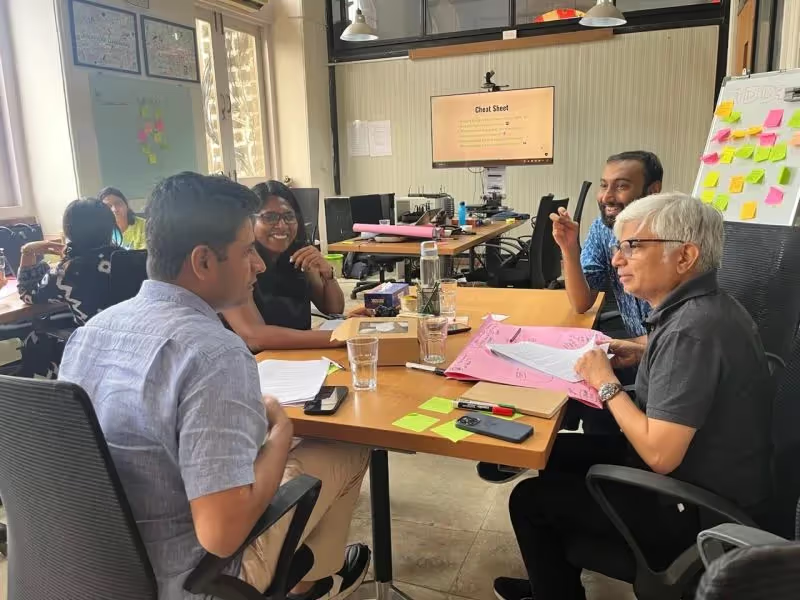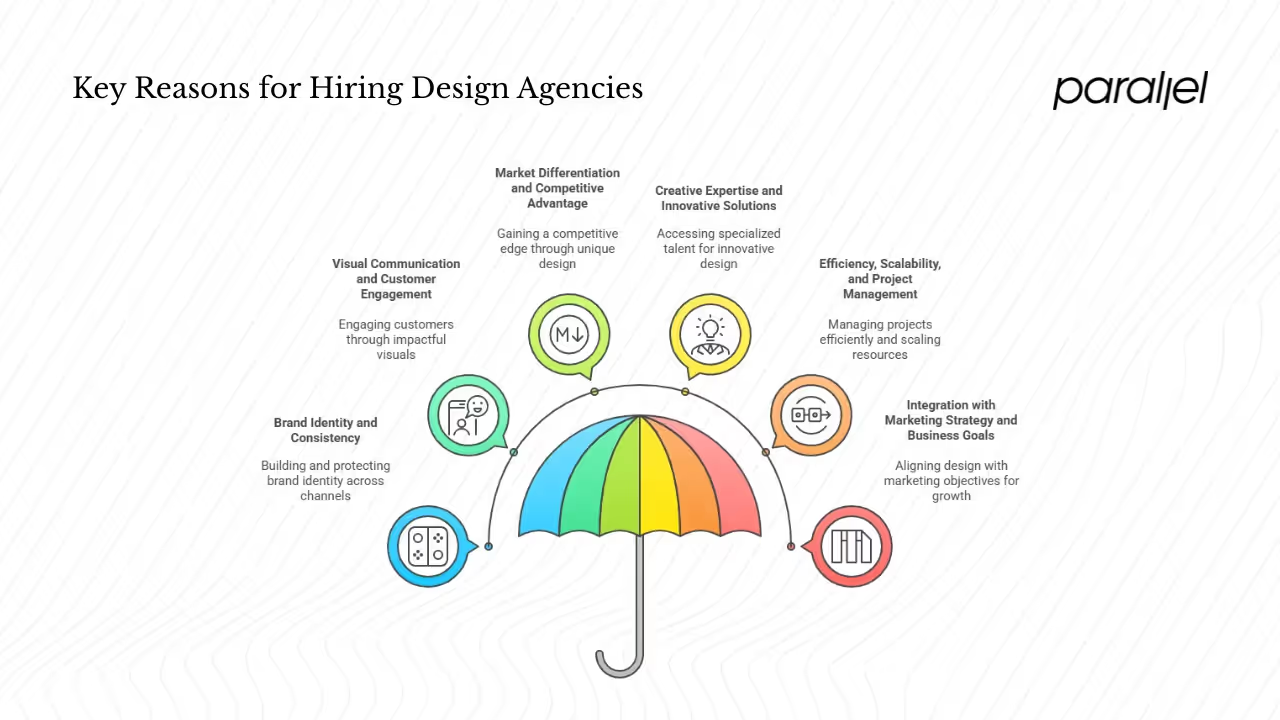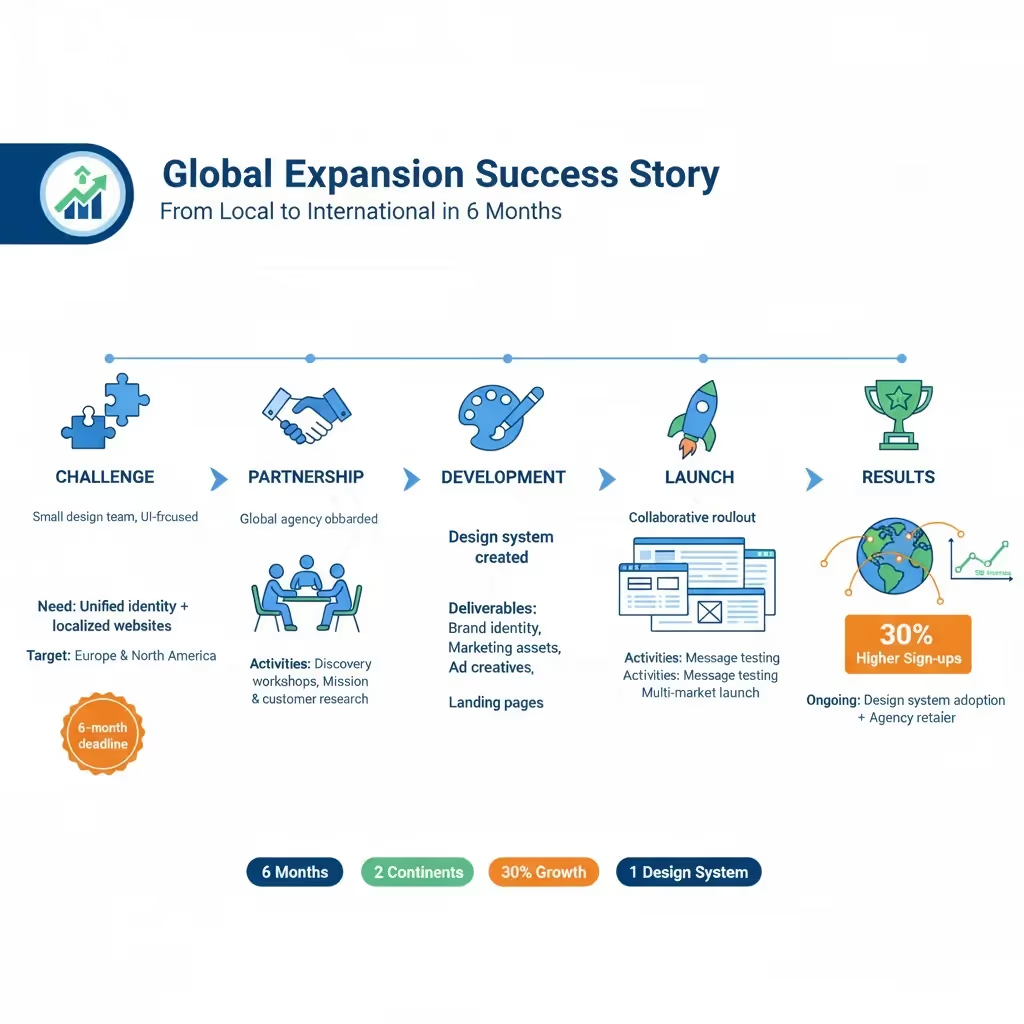Why Do Large Companies Hire Design Agencies? Guide (2025)
Explore reasons large companies hire design agencies, including specialized expertise, scalability, and fresh perspectives.

When you lead a growing organisation, the question why do large companies hire design agencies tends to surface sooner or later. The short answer is that design is about much more than making things look good. It drives perception, trust and business outcomes. Large firms turn to agencies for strategic thinking, specialised skills and the ability to deliver big projects on tight deadlines.
In this article, I’ll unpack the main reasons — from brand identity to market differentiation, creative expertise and customer engagement — and share insights from work with startups and enterprises.
What is a design agency and what do they do?
A design agency is a company that shapes how people see and interact with a brand. Unlike a lone freelancer or a small in‑house team, an agency brings together researchers, UX designers, brand strategists, copywriters and project managers. They offer services such as brand identity development, visual communication, user interface and experience design, marketing collateral and innovation. According to a branding guide, even organisations with in‑house creatives still partner with agencies because they provide wide‑ranging knowledge, industry experience and cost effectiveness.

Scale is where this distinction becomes critical. Enterprises operate across multiple regions and products and must maintain consistent visuals while coordinating complex roll‑outs. Freelancers might craft a logo or a small app, but they lack the capacity to manage a global rebrand. Agencies scale up or down and apply processes honed on similar projects. UX Studio reports that long‑term relationships with agencies let companies adjust headcount flexibly, keeping teams lean while meeting fluctuating workloads. At this stage the answer is capacity and depth: agencies deliver breadth that small internal teams can’t match.
Service overview
- Brand identity: defining the visual and verbal signature of a company — logos, colours, typography and messaging. Agencies ensure this identity remains consistent across channels.
- Visual communication: creating visuals that communicate complex ideas quickly, including illustrations, animations and data visuals.
- UI/UX design: designing interfaces for web and mobile, conducting user research and testing prototypes.
- Marketing collateral: producing campaigns, ads, video, packaging and presentations that reflect the brand and support business goals.
Top reasons large companies hire design agencies

1) Brand identity and consistency
The first reason why large companies hire design agencies is to build and protect their identity. Big organisations sell multiple products in many markets. Without a shared identity, every brochure, website and slide deck can drift, eroding trust and recognition. A 2024 branding guide reports that 46% of consumers pay more to brands they trust and that consistent branding can lift revenue by a third. An agency builds a clear identity, documents how to use it and enforces those rules across channels.
2) Visual communication and customer engagement
Human brains process images much faster than text. Clear visual communication guides people through a story or interface and prompts them to act. Agencies dig into your brand positioning, customer behaviour and competition, then customize visuals that match your values and encourage action. They understand colour psychology and typography. DesignRush reports that 94% of first impressions come from design and 88% of consumers will not return after a poor experience. Agencies apply this data to craft engaging experiences and build loyalty. That’s another answer to why do large companies hire design agencies — to connect with customers using research‑backed visuals.
3) Market differentiation and competitive advantage
In crowded markets, features often look similar. Design becomes a separator that drives choice. McKinsey found that companies with top design scores grew revenue 32% faster and delivered 56% higher returns. Agencies help harness this advantage by bringing fresh perspectives and unbiased insights. According to OutsourcingBuddy, agencies provide professional expertise, stay on top of trends and offer creative solutions. Chimento Agency adds that design firms adapt their process to your goals and draw ideas from different industries. That’s another answer to why large companies hire design agencies: they add a competitive edge.
4) Creative expertise and innovative solutions
Another reason why large companies hire design agencies is access to talent. Agencies house teams of specialists — designers, strategists and researchers — who work together. Chimento points out that this multidisciplinary approach ensures every aspect of a project is thoughtfully executed. Penji explains that agencies recruit top talent and stay current with trends, while UX Studio adds that rigorous hiring and training give clients high standards. Working with an agency gives you the collective brainpower of a seasoned design team instead of a lone generalist.
5) Efficiency, scalability and project management
One practical reason why large companies hire design agencies is that large campaigns and product launches involve many moving pieces. Agencies bring processes, tools and people to manage parallel workstreams and hit deadlines. UX Studio explains that long‑term partnerships let companies flex resources and stay lean. OutsourcingBuddy emphasises time and resource efficiency: businesses focus on their core competencies while agencies complete design work. Penji adds that agencies simplify workflows and save money.
6) Integration with marketing strategy and business goals
If you wonder why large companies hire design agencies when they already have marketing teams, keep in mind that design decisions must support marketing objectives and growth. Penji explains that agencies dive into your brand positioning, customer behaviour and competition, then customise your visual identity to match your values. They understand how colour, typography and layout guide user actions. Forrester reports that well‑designed interfaces can boost conversion rates by up to 400%, and that increasing UX budgets by 10% can raise conversions by 83%. Agencies connect design decisions with metrics so that creative work supports customer acquisition, retention and brand equity.
When does it make sense for a large company to hire an agency?
Not every job needs outside help. Maintenance work and small iterations often stay in‑house. An external partner is most useful for major, complex or high‑stakes initiatives. Here are common triggers:
- Launching new products or entering new markets: Coordinating regions, languages and channels requires scale. Agencies can provide that scale.
- Refreshing or repositioning your brand: A rebrand is more than a new logo. It needs research, identity work and roll‑out across packaging, sites and ads.
- Lacking specialised skills: For design system audits, accessibility overhauls or complex research, agencies provide experts who accelerate learning.
- Fluctuating workloads or tight timelines: Agencies ramp up quickly to absorb spikes and keep teams lean.
- Needing fresh, objective perspectives and data‑driven decisions: Agencies bring outside eyes, propose new approaches and tie design choices to conversion and retention metrics.
In our practice, we’ve seen clients delay projects by trying to handle everything internally. Once they engage a partner, they accelerate go‑to‑market timelines and reduce stress on teams.
How to choose the right design agency
Selecting a partner should be deliberate. Consider these points when choosing an agency:
- Define your goals clearly. Clarify whether you need a brand identity, a product launch, a design system or ongoing support. A shared brief helps agencies propose the right team and process.
- Review their work and industry fit. Look for consistent branding across channels and evidence of differentiation. Ask to see case studies in your sector and discuss how they measure success — conversion, retention or brand lift.
- Understand their process and scalability. Good agencies invest in research, ideation, prototyping and testing. Ensure they can scale for large campaigns and provide specialists when needed.
- Check cultural fit and communication. Evaluate how the team listens, challenges assumptions and provides feedback. Discuss expectations around meetings, tools, decision‑making and support.
- Clarify metrics, support and pricing. Agree on how progress will be measured, whether you need a retainer or a fixed‑scope project and what governance looks like.
Open conversations about objectives, budgets and constraints lead to the best outcomes. When in doubt, run a small pilot project first.
Potential challenges and how to mitigate them
Hiring an agency isn’t risk‑free. Consider these common challenges and ways to address them:

- Cost and budgeting: Agencies often cost more than freelancers. Agree on scope, milestones and payment terms up front. View design as an investment: design‑led companies grow faster and deliver higher returns.
- Communication, scope and coordination: Poor expectations or uncontrolled scope can derail projects. Set up regular check‑ins, document decisions, appoint internal champions and define clear deliverables and change‑management processes. Bring the agency into product, engineering and marketing early to avoid silos.
- Quality variation: Large agencies have varied teams. Ask to meet your core team and review individual portfolios. Agencies like UX Studio invest in rigorous hiring and training to ensure high standards.
- Internal resistance: In‑house teams may feel threatened. Present the agency as an extension of the team and encourage knowledge sharing.
Longer partnerships often yield better results because the agency learns more about your business and can anticipate needs.
Hypothetical scenario
Imagine a fast‑growing Indian software company launching a product in Europe and North America. Its small design team focuses on UI but now needs a unified identity, marketing assets and localised websites within six months. They bring in a global agency that runs workshops to understand the mission and customers, develops a design system and creates visuals for ads and landing pages. Working with marketing, the agency tests messages and launches on schedule. Sign‑ups are 30% higher than previous releases. The internal team keeps using the design system while the agency stays on retainer for campaigns.

Conclusion
The next time you find yourself asking why large companies hire design agencies, think about past aesthetics. Agencies deliver specialised skills, multidisciplinary teams, tested processes and the capacity to tackle complex projects. They help companies define a strong identity, craft engaging visuals, stand out in crowded markets, access top talent, scale quickly and link design work to business goals. Studies show that design‑centred firms grow faster and generate higher returns, while poor design drives customers away.
In my experience, hiring the right agency is an investment that boosts conversion, retention and brand equity. With early‑stage teams, design partners clarify product thinking and encourage collaboration. Involving design experts early speeds iteration and prevents inconsistent visuals. Before you hire, assess your goals, resources and ambition. If your team lacks the depth to deliver at scale, the expertise of an agency can accelerate your path.
Review your capabilities. If your needs match the triggers above, partnering with a design agency could be the catalyst for your next growth phase. A design partner can transform how your brand connects with customers.
FAQ
1) Why do companies go through recruiting agencies?
Recruiting agencies help companies find and hire people quickly by maintaining candidate pools and handling screening and negotiations. This saves time and lets firms scale without a large HR team. The same logic applies in design: an agency provides a ready team instead of hiring each role yourself.
2) What does a design agency do?
A design agency shapes your brand identity, crafts visuals and designs interfaces. It runs research, develops concepts, creates assets and ensures every touchpoint feels coherent. Many agencies also provide marketing strategy, copywriting and development services.
3) Why do so many advertisers hire agencies?
Advertising campaigns require strategy, creativity and execution across media. Agencies specialise in this blend and connect ads with the brand’s wider identity.
4) Why do companies hire product designers?
Product designers research user needs, design interfaces, test prototypes and refine features. Hiring product designers — or partnering with agencies that have them on staff — improves engagement and retention. Forrester reports that well‑designed interfaces can boost conversion by up to 400%, while a modest increase in UX budget can raise conversions by 83%; better usability often doubles conversion.









.avif)



